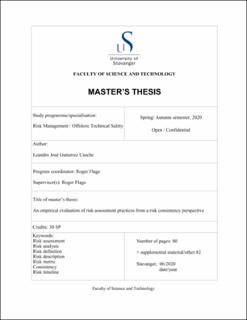| dc.description.abstract | Risk assessments form the core of the modern risk management process. Based on the execution of risk analysis and subsequent risk evaluations, the risk assessments provide the stakeholders or decision-makers with the ‘risk picture’ of a given activity. The degree to which a decision made by the stakeholders will have the desired effect or any effect at all, will depend to a high extent on the quality level of the presented risk picture. At the same time, the risk picture relies on the quality of the risk analysis performed. And finally, the results of the risk analysis will ultimately depend on the concept of risk that is used. It is clear that risk is the keyword of the whole process, and therefore it is of high importance to utilize the definition whose associated description includes all the involved elements. There are several conceptualizations of risk and each one contain different elements, under these definitions there are unique ways to assess, measure and describe risk. As not all the definitions of risk contain the same elements, it is important that the risk definition in use is consistent with the way it is measured or described. The main objective in this work is to evaluate the consistency between the way risk is defined and the way risk is described in today’s risk assessment practices with the purpose of increasing the scientific knowledge within this subject and contribute to a better execution of risk assessment techniques. The strategy followed in the present research is outlined in a general way by the following sequence. First, relevant risk assessment of different types and from different sectors were collected. Then an evaluation of the collected data was performed with focus on the way risk is defined. The risk definitions were then compared against the associated risk descriptions and then the results were discussed with reference to the main objective of the thesis. Finally, the conclusions and possible recommendations were presented. The results showed that as a rule, the risk descriptions of the majority of the risk assessments evaluated, present more than just the elements contained in their respective definitions. It is argued that this could be due to the necessity of the risk analysts to express more than just what is entailed by the risk definitions in use. It was concluded that, in general and as per the evaluated sample, the risk definitions can be deemed consistent with the risk descriptions up to a certain degree. Consistent in the sense that a good number of assessments manage to describe the elements that conform their respective risk definitions, though not completely consistent as the risk descriptions usually included more than such elements. The one exception was when the definition of risk used was the two-dimensional combination of consequences of an activity and associated uncertainty, which successfully managed to cover all the elements presented in the evaluated risk descriptions. Finally, it is also argued that a risk definition that manages to cover all the risk elements under its related risk description will help the risk assessment team to both accurately communicate the results of the analysis while at the same time keeping the consistency between the risk definition and the risk description. | en_US |
